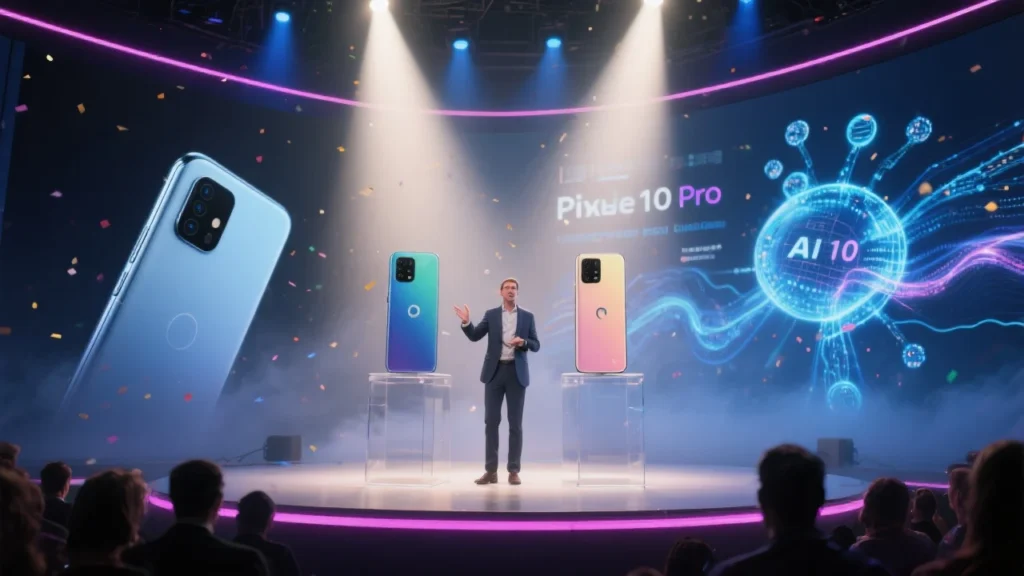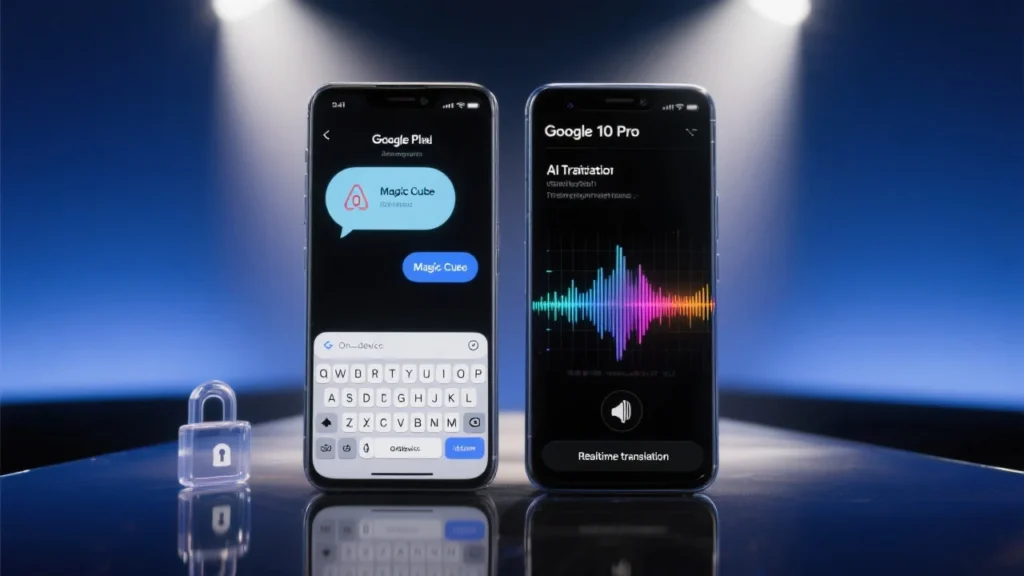Google has officially unveiled its latest flagship smartphones, the Pixel 10, 10 Pro, and 10 Pro XL, marking a significant milestone in the company’s smartphone evolution. These devices represent more than just incremental upgrades they’re a bold statement about the future of mobile technology, packed with groundbreaking features that could reshape how we interact with our phones.

The Heart of Innovation: Tensor G5 and Enhanced Performance
At the core of Google’s new lineup lies the revolutionary Tensor G5 chipset, marking a pivotal shift in the company’s silicon strategy. For the first time in five generations, Google has partnered with TSMC instead of Samsung to manufacture its custom processor. This change brings substantial performance improvements that users will notice immediately.
The Tensor G5 delivers an impressive 34 percent faster CPU performance compared to its predecessor, the Tensor G4. However, the real game-changer lies in its AI capabilities. Google claims a remarkable 60 percent performance increase for on-device AI tasks handled by the TPU (Tensor Processing Unit). This enhancement enables the phones to process complex AI operations locally, reducing reliance on cloud computing and improving both speed and privacy.
These performance gains translate into real-world benefits. Apps launch faster, multitasking becomes smoother, and the new AI features run seamlessly without draining battery life. The shift to TSMC’s manufacturing process also promises better power efficiency, contributing to longer battery life across all three models.
Pixelsnap: Google’s Answer to MagSafe
One of the most anticipated features finally arrives with the Pixel 10 series: Qi2 wireless charging support. Google has branded its implementation as “Pixelsnap,” introducing MagSafe-like magnetic functionality to Android devices. This long-awaited addition makes the Pixel 10 series the first major Android flagship to offer proper Qi2 support with embedded magnets.
The magnetic ring on the back panel opens up a world of accessories. Google will launch with its own magnetic stand charger featuring a detachable wireless charging puck, plus a ring-type grip that doubles as a stand. More importantly, the Pixel 10 series gains compatibility with the vast ecosystem of existing MagSafe accessories, giving users unprecedented choice in how they accessorize their devices.
Charging speeds vary across the lineup. The standard Pixel 10 and 10 Pro support up to 15W wireless charging, while the 10 Pro XL takes advantage of the latest Qi2.2 standard, supporting up to 25W wireless charging speeds. This differentiation ensures that power users get the fastest possible charging experience.
Camera Evolution: AI Meets Photography
Google continues to push the boundaries of computational photography with the Pixel 10 series, though the approach varies across models. The regular Pixel 10 makes some compromises, adopting a smaller 48-megapixel sensor borrowed from the budget-friendly Pixel 9A, rather than sharing the Pro models’ larger 50-megapixel sensor. However, it gains its first proper telephoto lens, offering 5x optical zoom capabilities.
The Pro models maintain their photography leadership with larger sensors and more advanced features. The 10 Pro and 10 Pro XL feature a 50-megapixel main camera with a substantial 1/1.3″-type sensor, paired with a 48-megapixel ultrawide camera that significantly outperforms the standard model’s 13-megapixel alternative.
Perhaps most controversially, Google introduces diffusion AI models for extreme zoom photography. On Pro models, shots taken above 30x zoom receive AI enhancement that transforms what would typically be unusable digital zoom into surprisingly detailed images. This generative AI processing happens after capture, doesn’t work on people, and results are properly tagged with C2PA content credentials to indicate AI editing.
The new AI Camera Coach provides step-by-step guidance for improving photo composition, though its practical utility remains to be seen. Additionally, the Magic Editor now accepts text prompts for photo editing, making advanced image manipulation more accessible to everyday users.
Revolutionary AI Features: Magic Cue and Beyond

The Pixel 10 series introduces Magic Cue, perhaps the most intriguing AI feature yet. This proactive assistant analyzes your recent phone activity and suggests relevant information contextually. If a friend texts asking for your Airbnb address, Magic Cue can automatically surface the address from your email and suggest it above the keyboard. When calling a business you’ve booked with, it can display relevant details like confirmation numbers.
All Magic Cue processing happens on-device, ensuring privacy while providing unprecedented convenience. The feature works primarily with Google’s first-party apps but extends to third-party applications through Gboard integration. Senior director of product management Shenaz Zack emphasizes that the system is “ephemeral” it won’t remember activities from a week ago and doesn’t save screen content.
The AI translator in the phone app represents another significant advancement. Unlike traditional robotic translations, this system uses AI to mimic the speaker’s voice characteristics, creating more natural-sounding translations that preserve the original speaker’s tone and cadence.
eSIM-Only Future: Following Apple’s Lead
In a move that mirrors Apple’s strategy, Google has eliminated physical SIM card slots from US versions of the Pixel 10 series. These devices support dual eSIM functionality, allowing two active eSIM profiles simultaneously while storing eight or more eSIM profiles for easy switching.
This transition creates challenges for users switching from other platforms, but Google has developed solutions. The company is working on cross-platform eSIM transfer functionality that will allow seamless migration from iPhone to Pixel 10. This feature requires iOS 26 and will likely debut alongside the iPhone 17 launch, enabling bidirectional eSIM transfers between iOS and Android devices.
Enhanced Specifications Across the Board
Battery improvements span the entire lineup. The Pixel 10 features a 4970mAh battery (up from 4700mAh), while the 10 Pro includes a 4870mAh capacity. The 10 Pro XL leads with a 5200mAh battery, ensuring all-day performance even with intensive AI processing.
Display brightness receives modest improvements across all models, enhancing outdoor visibility and HDR content consumption. The screens maintain Google’s commitment to high refresh rates and color accuracy while becoming more power-efficient thanks to the new chipset.
Breakthrough in Foldable Technology
The Pixel 10 Pro Fold achieves what seemed impossible: full IP68 dust and water resistance in a foldable device. This represents a major breakthrough in foldable technology, as previous devices from all manufacturers could only achieve partial dust protection with IP48 ratings that guard against particles larger than one millimeter.
Google’s new gear-less hinge design provides better drop protection while maintaining the smooth folding action users expect. The outer display grows to 6.4 inches (from 6.3 inches) despite the device becoming slightly narrower when folded. The inner 8-inch display achieves 3,000 nits peak brightness, improving outdoor usability.
This dust resistance breakthrough addresses the primary concern that has prevented many users from adopting foldable phones. With full protection against sand, dust, and other fine particles, the Pixel 10 Pro Fold becomes the first foldable truly suitable for beach trips and outdoor adventures.
Simplified iPhone Migration
Google recognizes that attracting iPhone users requires removing friction from the switching process. Beyond hardware compatibility, the company has developed comprehensive migration tools. Users who pre-order or purchase Pixel 10 devices directly from Google receive preparatory emails that help organize iPhone data for transfer, including passwords, wallet items, and app data.
The enhanced My Pixel app works alongside contextual tips that appear as new Android users navigate their devices. These features guide users through basic functions like taking screenshots or powering off the device, easing the transition from iOS conventions.
An on-device AI-powered support agent provides instant troubleshooting assistance and can seamlessly transfer users to live customer support when needed. This comprehensive approach addresses the intimidation factor that often prevents platform switching.
Pricing and Availability

Google maintains competitive pricing across the lineup. The Pixel 10 starts at $799, matching last year’s price point. The 10 Pro begins at $999, while the 10 Pro XL starts at $1,199 for the 256GB model Google has eliminated the cheaper 128GB variant this year.
The Pixel 10 Pro Fold commands a premium at $1,799, matching the previous generation’s starting price while delivering significantly enhanced durability and features. All devices are available for pre-order immediately, with general availability beginning August 28th. The Pro Fold follows on October 9th.
The Broader Impact
The Pixel 10 series represents Google’s most ambitious smartphone effort yet. By combining breakthrough hardware innovations like full dust resistance in foldables with advanced AI features that run entirely on-device, Google is setting new standards for what users should expect from premium smartphones.
The shift to TSMC manufacturing for the Tensor G5 signals Google’s commitment to competing directly with Apple’s silicon prowess. The addition of Qi2 support finally brings Android devices into parity with iPhone magnetic accessory ecosystems. Most importantly, the focus on on-device AI processing addresses privacy concerns while delivering genuinely useful features.
These phones don’t just represent incremental improvements they showcase Google’s vision for the future of mobile computing, where AI seamlessly integrates into daily tasks while maintaining user privacy and device performance.









